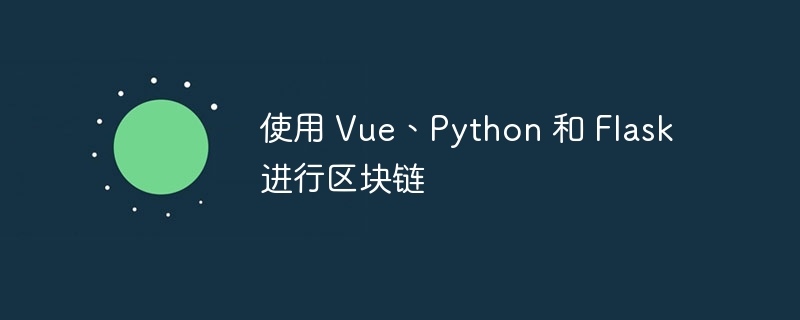使用 Vue、Python 和 Flask 进行区块链

使用 vue.js 前端和 python 后端创建完整的区块链应用程序。
让我们概述基本组件并提供一些示例代码片段来帮助您入门。
概述
- 1.后端(python 与 flask) 创建一个简单的区块链结构。 设置 flask api 与区块链交互。
- 2.前端 (vue.js)
- 创建一个与 flask api 通信的 vue.js 应用程序。
- 显示区块链数据并允许用户交互(例如添加新块)。 第 1 步:设置后端
- 安装 flask:确保已安装 flask。您可以使用 pip 来执行此操作:
设置环境
pip install flask
- 创建一个基本的区块链类:
# blockchain.py import hashlib import json from time import time from flask import flask, jsonify, request class blockchain: def __init__(self): self.chain = [] self.current_transactions = [] self.new_block(previous_hash='1', proof=100) def new_block(self, proof, previous_hash=none): block = { 'index': len(self.chain) + 1, 'timestamp': time(), 'transactions': self.current_transactions, 'proof': proof, 'previous_hash': previous_hash or self.hash(self.chain[-1]), } self.current_transactions = [] self.chain.append(block) return block def new_transaction(self, sender, recipient, amount): self.current_transactions.append({ 'sender': sender, 'recipient': recipient, 'amount': amount, }) return self.last_block['index'] + 1 @staticmethod def hash(block): block_string = json.dumps(block, sort_keys=true).encode() return hashlib.sha256(block_string).hexdigest() @property def last_block(self): return self.chain[-1] app = flask(__name__) blockchain = blockchain() @app.route('/mine', methods=['post']) def mine(): values = request.get_json() required = ['proof', 'sender', 'recipient'] if not all(k in values for k in required): return 'missing values', 400 index = blockchain.new_transaction(values['sender'], values['recipient'], values['amount']) blockchain.new_block(values['proof']) response = { 'message': f'new block forged', 'index': index, 'block': blockchain.last_block, } return jsonify(response), 200 @app.route('/chain', methods=['get']) def full_chain(): response = { 'chain': blockchain.chain, 'length': len(blockchain.chain), } return jsonify(response), 200 if __name__ == '__main__': app.run(debug=true)
第 2 步:设置前端
vue create my-blockchain-app
- 安装 axios 进行 api 调用:
npm install axios
- 创建一个简单的组件:
// src/components/blockchain.vue <template><div> <h1>blockchain</h1> <button>fetch blockchain</button> <ul> <li v-for="block in blockchain" :key="block.index"> block #{{ block.index }} - {{ block.timestamp }} </li> </ul> </div> </template><script> import axios from 'axios'; export default { data() { return { blockchain: [] }; }, methods: { fetchchain() { axios.get('http://localhost:5000/chain') .then(response => { this.blockchain = response.data.chain; }) .catch(error => { console.error(error); }); } } }; </script>
第三步:将它们放在一起
运行 flask 后端:确保您的 python 服务器正在运行:
python blockchain.py
运行 vue.js 前端:现在,运行您的 vue.js 应用程序:
npm run serve
让我们通过添加更多高级功能来增强区块链应用程序,例如:
- 工作量证明机制:实现基本的工作量证明算法。
- 交易池:允许用户创建交易并在挖矿之前在池中查看它们。 -节点发现:允许多个节点连接并共享区块链。 -改进的前端:创建更具交互性的用户界面来显示区块链和交易。 第 1 步:增强后端
- 更新区块链类 我们将实现基本的工作量证明算法和交易池。
# blockchain.py import hashlib import json from time import time from flask import flask, jsonify, request from urllib.parse import urlparse import requests class blockchain: def __init__(self): self.chain = [] self.current_transactions = [] self.nodes = set() self.new_block(previous_hash='1', proof=100) def new_block(self, proof, previous_hash=none): block = { 'index': len(self.chain) + 1, 'timestamp': time(), 'transactions': self.current_transactions, 'proof': proof, 'previous_hash': previous_hash or self.hash(self.chain[-1]), } self.current_transactions = [] self.chain.append(block) return block def new_transaction(self, sender, recipient, amount): self.current_transactions.append({ 'sender': sender, 'recipient': recipient, 'amount': amount, }) return self.last_block['index'] + 1 @staticmethod def hash(block): block_string = json.dumps(block, sort_keys=true).encode() return hashlib.sha256(block_string).hexdigest() @property def last_block(self): return self.chain[-1] def proof_of_work(self, last_proof): proof = 0 while not self.valid_proof(last_proof, proof): proof += 1 return proof @staticmethod def valid_proof(last_proof, proof): guess = f'{last_proof}{proof}'.encode() guess_hash = hashlib.sha256(guess).hexdigest() return guess_hash[:4] == "0000" # adjust difficulty here def register_node(self, address): parsed_url = urlparse(address) self.nodes.add(parsed_url.netloc) def resolve_conflicts(self): neighbours = self.nodes new_chain = none max_length = len(self.chain) for node in neighbours: response = requests.get(f'http://{node}/chain') if response.status_code == 200: length = response.json()['length'] chain = response.json()['chain'] if length > max_length and self.valid_chain(chain): max_length = length new_chain = chain if new_chain: self.chain = new_chain return true return false def valid_chain(self, chain): last_block = chain[0] current_index = 1 while current_index <p>第 2 步:增强前端</p> <ol> <li>在 vue.js 中创建交易表单 我们现在将创建一个表单供用户提交交易。 </li> </ol>// src/components/blockchain.vue <template><div> <h1>blockchain</h1> <button>fetch blockchain</button> <h2>transactions</h2> <form> <input type="text" v-model="sender" placeholder="sender" required><input type="text" v-model="recipient" placeholder="recipient" required><input type="number" v-model="amount" placeholder="amount" required><button type="submit">send transaction</button> </form> <h2>blockchain</h2> <ul> <li v-for="block in blockchain" :key="block.index"> block #{{ block.index }} - {{ block.timestamp }} <ul> <li v-for="transaction in block.transactions" :key="transaction.sender"> {{ transaction.sender }} -> {{ transaction.recipient }}: {{ transaction.amount }} </li> </ul> </li> </ul> </div> </template><script> import axios from 'axios'; export default { data() { return { blockchain: [], sender: '', recipient: '', amount: 0, }; }, methods: { fetchchain() { axios.get('http://localhost:5000/chain') .then(response => { this.blockchain = response.data.chain; }) .catch(error => { console.error(error); }); }, submittransaction() { const transaction = { sender: this.sender, recipient: this.recipient, amount: this.amount, }; axios.post('http://localhost:5000/transactions/new', transaction) .then(response => { alert(response.data.message); this.fetchchain(); // refresh the blockchain view }) .catch(error => { console.error(error); }); } } }; </script>第三步:节点发现和共识
您可以通过在不同端口上运行 flask 应用程序的多个实例来测试具有多个节点的区块链。例如,您可以运行:
flask_run_port=5001 python blockchain.py然后,您可以使用 post 请求注册节点:
curl -X POST -H "Content-Type: application/json" -d '{"nodes": ["localhost:5001"]}' http://localhost:5000/nodes/register这个更先进的区块链应用程序包括:
-工作量证明:挖掘新区块的基本机制。
-交易池:用户可以在交易被开采之前创建交易。
-节点发现:支持多个节点和共识机制。
-交互式前端:用于提交交易和查看区块链的 vue.js ui。编码愉快!
